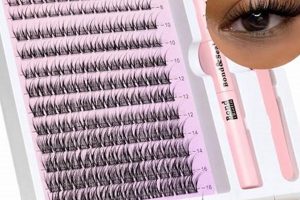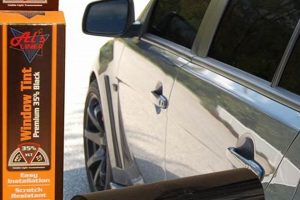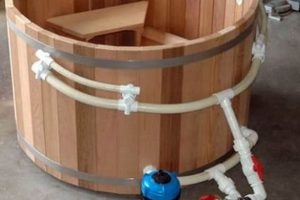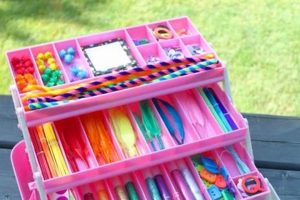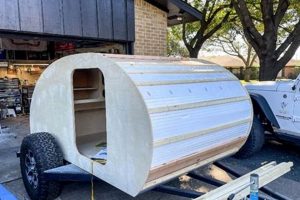A do-it-yourself Bluetooth speaker assembly offers a collection of components enabling individuals to construct a functioning wireless speaker. This typically includes a speaker driver, amplifier board, Bluetooth module, enclosure materials, wiring, and necessary hardware. For example, a kit might provide all the parts needed to build a portable speaker that can connect to a smartphone or tablet via Bluetooth. The appeal of such kits lies in the hands-on experience and the opportunity to understand the inner workings of audio electronics.
The value of these projects stems from several factors. Primarily, they provide an educational platform for learning about electronics, acoustics, and audio engineering principles. Moreover, completing such a project can be a cost-effective alternative to purchasing a pre-assembled speaker, particularly for those seeking a customized audio solution. Historically, building audio equipment was a common practice among hobbyists and engineers. Modern kits democratize this process, making it accessible to a wider audience interested in electronics and sound reproduction.
The following sections will delve into the components typically found in these sets, the tools required for assembly, and the considerations for selecting a suitable kit based on skill level and desired outcome.
Essential Guidance for Building a Wireless Audio System
The successful construction of a wireless audio system from a component set requires careful planning and execution. These guidelines aim to provide practical advice for achieving optimal results.
Tip 1: Component Compatibility: Verify the voltage and power requirements of all included parts, such as the amplifier board and speaker driver. Incompatible components can lead to malfunctions or damage during operation. Consult the kit’s documentation and datasheets for detailed specifications.
Tip 2: Enclosure Design: The enclosure’s design significantly impacts the sound quality. Consider the internal volume and porting (if applicable) to optimize the speaker’s frequency response. A sealed enclosure might offer tight bass, while a ported enclosure could provide enhanced low-end extension.
Tip 3: Solder Joint Integrity: Ensure all solder joints are clean, shiny, and mechanically sound. Cold solder joints, characterized by a dull or grainy appearance, can cause intermittent connection issues and signal degradation. Apply sufficient heat and solder to create a robust connection.
Tip 4: Bluetooth Module Configuration: Configure the Bluetooth module according to the manufacturer’s instructions. This may involve setting the device name, pairing password, and other parameters. Incorrect configuration can prevent the device from pairing with other Bluetooth-enabled devices.
Tip 5: Wiring Management: Implement proper wiring management to prevent shorts and signal interference. Use shielded cables for audio signals where possible. Secure wires with zip ties or adhesive clips to maintain a neat and organized internal layout.
Tip 6: Testing and Troubleshooting: Before final assembly, test each circuit stage individually. Use a multimeter to check for continuity and voltage levels. If issues arise, systematically troubleshoot each connection and component to identify the source of the problem.
Tip 7: Power Supply Selection: Choose a power supply that meets or exceeds the kit’s voltage and current requirements. Using an undersized power supply can result in reduced performance or system instability. Consider a regulated power supply to ensure consistent performance.
Following these guidelines promotes a successful assembly process, leading to a functional and well-performing custom audio device. Diligence and precision are key to achieving the desired outcome.
The subsequent section will address common challenges and solutions encountered during construction, including component selection and circuit debugging.
1. Speaker Driver
The speaker driver is a pivotal element within any do-it-yourself Bluetooth speaker construction. It serves as the electroacoustic transducer, directly converting electrical signals from the amplifier into audible sound. Consequently, the speaker driver’s characteristics profoundly affect the resulting audio fidelity, frequency response, and overall sound pressure level achievable by the assembled Bluetooth speaker. A poorly chosen driver can severely limit the potential of an otherwise well-designed system. For example, a driver with a limited frequency range will fail to reproduce low bass tones or high-frequency details accurately.
Selecting the appropriate speaker driver necessitates a careful assessment of technical specifications and desired performance characteristics. Parameters such as impedance, sensitivity, frequency response, and power handling capacity must align with the amplifier module’s capabilities and the intended application of the Bluetooth speaker. For instance, if the kit will be used primarily for outdoor listening, a driver with higher sensitivity and power handling is preferable to overcome ambient noise. Conversely, for indoor use, a driver optimized for balanced frequency response may be more suitable. The enclosure design also has strong effect with speaker driver.
In summary, the speaker driver is not merely a component of a DIY Bluetooth speaker kit but rather the core element dictating its sonic capabilities. Accurate selection and proper integration of the driver are paramount for achieving satisfactory audio performance. The relationship is symbiotic; the quality of the driver directly determines the quality of the output of the overall kit. Understanding this relationship is critical for a successful project.
2. Amplifier Module
The amplifier module represents a critical component within a do-it-yourself Bluetooth speaker kit, tasked with boosting the low-level audio signal from the Bluetooth receiver to a power level sufficient to drive the speaker driver effectively. Its selection and proper integration directly influence the speaker’s output volume, clarity, and overall audio performance.
- Gain and Power Output
The amplifier module’s gain dictates the amplification factor applied to the input signal, while its power output determines the maximum volume the speaker can achieve without distortion. For example, a module with insufficient power output will result in a weak and unsatisfying sound, particularly in noisy environments. Conversely, excessive gain can lead to clipping and distortion, degrading the audio quality.
- Efficiency and Heat Dissipation
Amplifier efficiency refers to the proportion of input power converted into output power, with the remainder being dissipated as heat. Less efficient modules require larger heat sinks or cooling mechanisms to prevent overheating and potential damage. Class D amplifiers are ofte
n preferred in DIY kits due to their high efficiency and compact size. Inefficient amplifier designs create additional complications for enclosure building due to the increased heat. - Signal-to-Noise Ratio (SNR) and Total Harmonic Distortion (THD)
The SNR indicates the ratio of the desired audio signal to the background noise, while THD measures the amount of harmonic distortion introduced by the amplifier. Lower SNR and higher THD values result in a muddier and less accurate sound reproduction. Premium amplifier modules prioritize low THD and high SNR for optimal audio fidelity. This is most important with high quality speaker drivers.
- Power Supply Requirements
The amplifier module’s power supply requirements must be carefully matched to the available power source. Insufficient voltage or current can lead to unstable operation or complete failure. Conversely, exceeding the module’s voltage limits can cause permanent damage. A stable and adequately sized power supply is essential for reliable performance of the entire DIY Bluetooth speaker system.
The selection of the amplifier module within a kit necessitates consideration of its performance characteristics, efficiency, and power requirements. A properly chosen and integrated amplifier module forms the backbone of a functional and high-performing do-it-yourself Bluetooth speaker, ensuring optimal audio output and overall system reliability. The amplifier is a critical component that will define the overall outcome.
3. Bluetooth Connectivity
Bluetooth connectivity is an indispensable feature of modern do-it-yourself speaker constructions. Its integration enables wireless audio streaming from a multitude of devices, enhancing convenience and versatility. The selection and implementation of the Bluetooth module are paramount to the overall user experience and functionality.
- Module Selection Criteria
The selection of a Bluetooth module should consider factors such as Bluetooth version (5.0 or later is generally preferred for improved range and stability), supported audio codecs (SBC, AAC, aptX), and power consumption. A module with aptX support, for example, can deliver higher-fidelity audio from compatible devices, while lower power consumption extends battery life in portable applications. Inadequate module selection can lead to limited compatibility or subpar audio quality.
- Pairing and Configuration
The Bluetooth module must be readily discoverable and pairable with various devices, including smartphones, tablets, and computers. Clear instructions and intuitive configuration options are essential for ease of use. Some modules offer customizable device names and pairing passwords for enhanced security. A poorly designed pairing process can result in user frustration and limited adoption of the speaker.
- Range and Stability
The operational range and connection stability of the Bluetooth module are critical for uninterrupted audio playback. Environmental factors, such as obstacles and interference from other wireless devices, can impact performance. A module with a strong antenna and robust signal processing capabilities can mitigate these issues. A weak or unstable connection negates the benefit of wireless audio by causing stuttering or disconnections.
- Integration and Antenna Placement
Proper integration of the Bluetooth module into the circuit and strategic antenna placement are necessary for optimal performance. Shielding the module from electromagnetic interference and positioning the antenna away from metal components can improve range and stability. Improper integration can significantly degrade Bluetooth performance, irrespective of the module’s inherent capabilities.
The incorporation of Bluetooth connectivity fundamentally transforms a basic speaker into a versatile audio device capable of seamless wireless operation. Careful consideration of module selection, configuration, and integration is crucial for realizing the full potential of this technology in a do-it-yourself speaker project. Neglecting these aspects can result in a compromised user experience and diminished overall satisfaction.
4. Enclosure Materials
The selection of enclosure materials within a do-it-yourself Bluetooth speaker kit is a critical determinant of the final product’s acoustic properties, structural integrity, and aesthetic appeal. The enclosure acts as the physical housing for the speaker driver, amplifier, and other electronic components, significantly influencing sound wave propagation and overall audio fidelity. The material chosen directly affects the speaker’s frequency response, resonance characteristics, and perceived sound quality. For example, a lightweight, flexible material may introduce unwanted vibrations, resulting in a muddied or distorted sound, particularly at higher volumes. Conversely, a rigid, dense material minimizes unwanted vibrations, allowing for clearer and more accurate sound reproduction. Therefore, the enclosure material is not merely a cosmetic element but rather an integral component that actively shapes the acoustic performance of the speaker.
Various materials are commonly employed in do-it-yourself Bluetooth speaker construction, each offering distinct advantages and disadvantages. Wood, particularly medium-density fiberboard (MDF), is often favored for its acoustic properties, ease of machining, and relatively low cost. Wood provides a good balance of rigidity and damping, minimizing unwanted resonances. Plastics, such as ABS or acrylic, offer durability, water resistance, and design flexibility. Plastic enclosures can be easily molded into complex shapes and are suitable for portable speaker designs. However, plastics may require additional damping materials to reduce unwanted vibrations. Metal enclosures, typically aluminum or steel, offer exceptional rigidity and heat dissipation capabilities, making them suitable for high-power speaker systems. Metal enclosures can also provide effective electromagnetic shielding, reducing interference with other electronic devices. The material’s density can also influence the bass response and overall sound projection. Different materials may yield different optimal internal volumes for the speaker. Therefore, choosing the proper volume along with the appropriate materials are very important.
In summary, the selection of enclosure materials represents a crucial decision in the assembly of a do-it-yourself Bluetooth speaker kit. The chosen material directly impacts the acoustic performance, structural integrity, and aesthetic appeal of the final product. Careful consideration of the material’s properties, such as density, rigidity, and damping characteristics, is essential for achieving optimal sound quality and overall system performance. Understanding the interplay between the enclosure material and the speaker’s acoustic behavior allows builders to tailor their designs to meet specific performance goals and aesthetic preferences. The challenges of material selection can be overcome by having a clear idea of acoustic and aesthetic targets.
5. Power Supply
The power s
upply is a foundational element within any do-it-yourself Bluetooth speaker assembly. It provides the necessary electrical energy for the amplifier, Bluetooth module, and other active components to function. A properly chosen power supply ensures stable operation, optimal performance, and protection against damage due to voltage fluctuations or current surges. Insufficient or improperly regulated power can lead to reduced output, distortion, or even component failure.
- Voltage and Current Requirements
Determining the appropriate voltage and current ratings for the power supply is paramount. Each component within the speaker system, particularly the amplifier module, has specific voltage and current demands. For example, a Class D amplifier module might require 12V at 2A, while the Bluetooth module operates at 3.3V with a current draw of 100mA. Exceeding the voltage limits can cause immediate damage, while providing insufficient current results in reduced performance or intermittent operation. Accurate calculation of total power needs is critical for selecting a suitable supply.
- Power Supply Types
Different power supply types are available for DIY speaker projects, each with its advantages and disadvantages. Linear power supplies offer low noise and excellent voltage regulation but are generally larger, heavier, and less efficient. Switching power supplies are more compact, lightweight, and efficient but can introduce noise into the audio signal if not properly filtered. Battery power provides portability but requires careful management to avoid over-discharge or overcharge. The choice of power supply type depends on the project’s specific requirements and priorities, balancing performance, size, and portability.
- Regulation and Filtering
Voltage regulation and filtering are essential for maintaining stable and clean power delivery to the speaker components. Voltage regulation ensures that the output voltage remains constant despite fluctuations in the input voltage or load current. Filtering reduces noise and ripple in the output voltage, preventing audible artifacts in the audio signal. For example, adding a capacitor in parallel with the power supply output can effectively filter out high-frequency noise. Implementing proper regulation and filtering is crucial for achieving optimal audio clarity and minimizing distortion.
- Safety Considerations
Safety is a primary concern when selecting and implementing a power supply. Protection against over-voltage, over-current, and short circuits is essential to prevent damage to the speaker components and ensure user safety. Using a power supply with built-in protection features, such as a fuse or circuit breaker, is highly recommended. Furthermore, proper grounding and insulation are necessary to minimize the risk of electrical shock. Adhering to safety standards and best practices is crucial for ensuring a safe and reliable DIY speaker system.
The power supply constitutes a fundamental aspect of any DIY Bluetooth speaker endeavor. Selecting the appropriate type, verifying adequate voltage and current ratings, ensuring proper regulation and filtering, and prioritizing safety features are all critical considerations. A well-chosen and properly implemented power supply guarantees stable operation, optimal performance, and long-term reliability of the assembled speaker system. A small oversight in this area can lead to significant performance issues.
6. Wiring & Connectors
The integrity of wiring and the reliability of connectors are fundamental to the successful assembly and operation of any do-it-yourself Bluetooth speaker kit. These often-overlooked components serve as the critical pathways for electrical signals and power, directly impacting audio quality, system stability, and overall longevity.
- Signal Transmission and Integrity
Wiring acts as the conduit for audio signals between the Bluetooth module, amplifier, and speaker driver. High-quality, shielded wiring minimizes signal loss and reduces interference, resulting in cleaner and more accurate sound reproduction. For example, using unshielded wire near a power source can introduce unwanted noise into the audio signal, degrading the listening experience. Proper wire gauge selection is also important to minimize resistance and ensure adequate signal transmission. Therefore, wire selection directly influence signal transfer.
- Power Delivery and Stability
Connectors and wiring must facilitate stable and efficient power delivery from the power supply to the amplifier and other components. Secure and low-resistance connections are essential for maintaining consistent voltage levels and preventing voltage drops that can compromise performance. For instance, loose or corroded connectors can create intermittent connections, leading to unreliable operation and potential component damage. Power delivery is critical for the overall health of the kit.
- Component Interconnection and Compatibility
Connectors provide the interface for linking various components within the system, such as the Bluetooth module, amplifier, and speaker driver. Selecting compatible connectors and ensuring secure connections are crucial for preventing signal loss and ensuring proper component function. Incompatible or poorly mated connectors can introduce impedance mismatches, resulting in signal reflections and distorted audio. This interconnection is the nervous system for the kit.
- Durability and Long-Term Reliability
The quality of wiring and connectors directly affects the long-term reliability of the DIY Bluetooth speaker. Robust materials and secure connections are essential for withstanding physical stress, vibration, and environmental factors that can degrade performance over time. Using low-quality connectors or wiring can lead to premature failure and require costly repairs or replacements. Thus, materials are essential for long-term use of the speaker kit.
In essence, the selection and implementation of wiring and connectors are not mere afterthoughts but rather integral aspects of a well-designed do-it-yourself Bluetooth speaker kit. Prioritizing high-quality materials, secure connections, and proper signal management is essential for achieving optimal audio performance, system stability, and long-term reliability. Neglecting these details can compromise the overall quality and enjoyment of the finished product. The selection and implementation of wiring and connectors are critical factors to the ultimate success of the project.
Frequently Asked Questions
This section addresses common inquiries and concerns regarding the assembly and utilization of do-it-yourself Bluetooth speaker kits, providing clarity and guidance for enthusiasts and builders.
Question 1: What level of technical expertise is required to assemble a DIY BT speaker kit?
The requisite technical expertise varies depending on the complexity of the kit. Basic kits may only necessitate simple soldering and component assembly skills, while advanced kits might demand a comprehensive understanding of circuit diagrams, component specifications, and troubleshooting techniques. Assessment of personal skill level before selecting a kit is advisable.
Question 2: What tools are essential for constructing a DIY BT speaker?
Essential tools typically include a soldering iron, solder, wire strippers, a multimeter, a screwdriver set, and pliers. A helping hand tool
can also be beneficial for holding components during soldering. Access to a drill and cutting tools may be necessary for enclosure modifications.
Question 3: How significantly does the enclosure material impact the sound quality of a DIY BT speaker?
The enclosure material exerts a substantial influence on the speaker’s acoustic properties. Rigid and dense materials, such as MDF, minimize unwanted vibrations and resonances, resulting in clearer and more accurate sound reproduction. Lightweight and flexible materials may introduce coloration and distortion, particularly at higher volumes.
Question 4: What are the key considerations when selecting a Bluetooth module for a DIY speaker project?
Crucial considerations include the Bluetooth version (5.0 or later is preferable), supported audio codecs (SBC, AAC, aptX), operational range, and power consumption. A module with aptX support delivers higher-fidelity audio, while low power consumption extends battery life in portable applications.
Question 5: How does one troubleshoot common issues encountered during DIY BT speaker assembly, such as no sound or distorted audio?
Troubleshooting typically involves systematically checking all connections, verifying component functionality with a multimeter, and ensuring that the power supply is providing the correct voltage and current. Identifying and rectifying cold solder joints is also crucial. Consulting the kit’s documentation or seeking online resources may provide additional guidance.
Question 6: What safety precautions should be observed when working with electrical components and soldering equipment in a DIY BT speaker build?
Safety precautions include wearing safety glasses to protect against solder splatter, working in a well-ventilated area to avoid inhaling fumes, and using a soldering iron with a grounded tip to prevent electrostatic discharge damage to sensitive components. Ensuring the power supply is properly grounded is also essential to minimize the risk of electric shock.
The information provided herein aims to address fundamental questions and concerns regarding the assembly and utilization of DIY Bluetooth speaker kits. Diligence and attention to detail are paramount for a successful and rewarding project.
The next section will offer concluding remarks and highlight potential future trends in do-it-yourself audio technology.
Concluding Remarks
This exploration has underscored the multifaceted nature of the DIY BT speaker kit. From fundamental component selection to meticulous assembly practices, each stage significantly influences the final product’s performance and reliability. Successful construction demands a foundational understanding of electronics, acoustics, and diligent adherence to best practices. The inherent value extends beyond mere cost savings, offering an engaging educational opportunity and the potential for a personalized audio solution.
The DIY BT speaker kit represents a gateway into the world of audio engineering and a tangible exercise in applied electronics. Continued advancements in Bluetooth technology, coupled with the increasing availability of sophisticated components, suggest a future where personalized audio solutions become even more accessible and refined. Individuals are encouraged to approach these projects with a spirit of inquiry and a commitment to meticulous execution. The pursuit of knowledge and craftsmanship remains the cornerstone of successful DIY endeavors.


